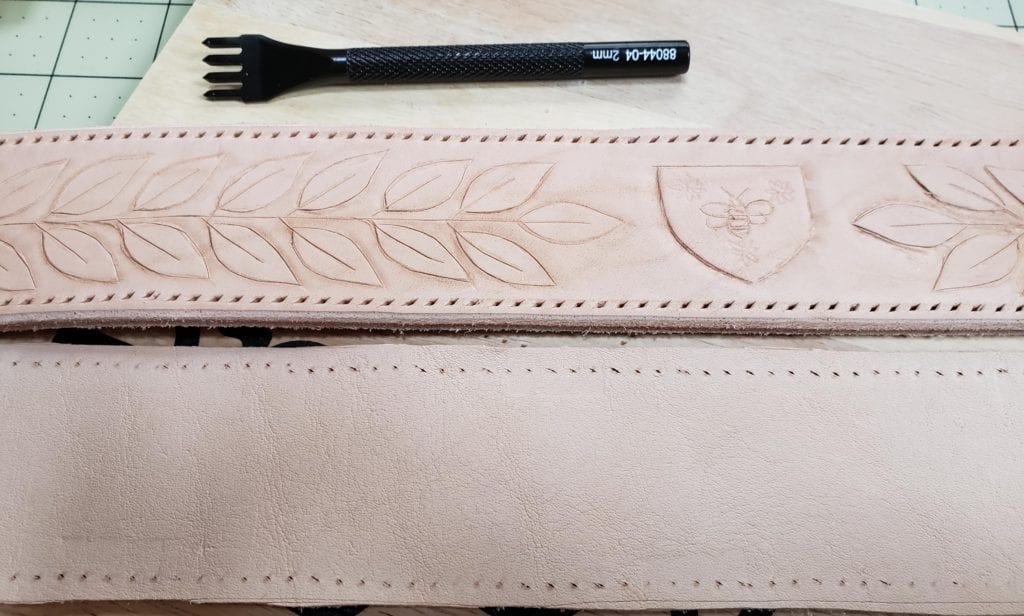I’ve typically been a bit of a “stealth Laurel,” but after seeing some of the Laurel wreaths worn by my brethren in the East Kingdom and the recent Tournaments Illustrated article[1]Schaeffer, Stephen. “A Laurel Headdress in 14th Century Style.” Tournaments Illustrated. Issue 209, 209 (1), pp. 5-10. about a fancy cloisonne wreath, I thought it would be cool to create one for myself to wear in court and whatnot. The Russian chronicles mention that Prince Daniil Romanovich of Galicia was known for having “boots of green leather, embroidered with gold”[2]Новицкая, М.А. “Золотная вышивка Киевской Руси.” Byzantinoslavica, 1972(33), p. 43. See my translation of the article here: https://rezansky.com/goldwork-embroidery-of-kievan-rus/. This gave me the idea to create a circlet of leather, with the leaves and my device in green decorated with gold thread.
My first step was to draw out the design on paper. I measured my head circumference, and created a design that was roughly 58 cm long. The width was 2 inches, based on the leather strap I bought.


Once I made sure the design would fit on the leather, I wet the leather, let it dry back to original color, then taped my design down using painter’s tape along one side. I used wax paper between the paper and the leather to keep it from getting soaked, and used a pen to trace the design. This transferred the design onto the leather, but also allowed me to lift the design and check my progress.

Once I was sure the entire design had been transferred, I removed the pattern, and used a craft knife to carve the design.

Once all the lines had been cut in, I used a bevel around the cuts to emphasize the design. Since I was going to be embroidering the circlet, I’d have threads pulled through to the back that would need to be covered up. To take care of this, I cut a strip of much thinner pig leather to use as the lining. After grooving in where the stitching would go to sew the two pieces together, I pinned the two pieces together (small binder clips work well for this), and used a stitching hole punch to create the holes through both pieces. This took a whole lotta hammering.

I then used an awl to punch holes around the shield, leaves, and along the leaf veins and stems. These holes will be used for couching stitches to hold down the gold thread, as well as for plunging the ends of the gold thread to the back. I was half expecting the awl to get dull through this work, but I was able to punch the holes without needing a hammer, and the awl’s point remained viciously sharp even after all this use.

The final stage to prep the leather for embroidery was to dye the leather brown, and then paint the shield and leaves green using a water-based leather paint. The green took several coats before it was as opaque and bright as I wanted it — next time I’ll put down a layer of white under brighter colors to see if that helps. The bee on my device will be painted in black, yellow and white for the wings, but I need to go pick up these colors.
Here you can see the dyed/painted leather, and the gold thread I plan to use on it.

Next time: goldwork on leather, aka, Ivan’s awl gets another workout.
Footnotes
| ↟1 | Schaeffer, Stephen. “A Laurel Headdress in 14th Century Style.” Tournaments Illustrated. Issue 209, 209 (1), pp. 5-10. |
|---|---|
| ↟2 | Новицкая, М.А. “Золотная вышивка Киевской Руси.” Byzantinoslavica, 1972(33), p. 43. See my translation of the article here: https://rezansky.com/goldwork-embroidery-of-kievan-rus/ |

